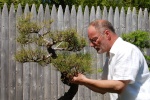an experiment
+2
Russell Coker
peter keane
6 posters
Page 1 of 1
 an experiment
an experiment
I acquired this fine cork bark japanese black pine last week at a local bonsai nursery. I'm told the variety is "arakawa". It is 2 ft high from the soil line. I didn't like the inverse taper at the bottom of the trunk. I presume that's a graft area. So, I thought I would see if I could encourage the small caliper trunk in that area to widen. To do so, I root grafted four japanese black pine seedlings around it. The theory is that when the plants fuse with the cork pine, they will cause the base to swell, making it more in proportion to the corked section above it. Since I'm raising the rootball the cork will be closer to the new soil line. When the caliper of the trunk is at a thickness I like, I'll remove the foliage of the seedlings. [img][/img]







peter keane- Member
 Re: an experiment
Re: an experiment
The method of grafting I'm using is called "tongued approach graft". A flap is opened on the cork pine at the thin base. A scion black pine shoot is sliced so that cambium is exposed to the underside of the flap of the corked pine. the sliced area is inserted into the flap. Then, the area is tied to the corked pine with grafting tape to ensure a good mechanical seal. I've attached four pines to the base. I'll check on the progress next spring. I'm probably going to leave the seedling foliage for a few years to encourage the base to swell. The tacks were a temporary measure to hold the seedlings long enough to allow me to wrap the area with polyethylene grafting tape.





peter keane- Member
 Re: an experiment
Re: an experiment
Nice pine Peter. I love those corkbark pines, can't wait to see how this works out.
There are lots of named selections of cb pines. Not sure if 'arakawa' is one or not, or just a descripton. But it may be, corkbark Japanese maples are also called arakawa momiji.
(not that any of that makes any difference...)
R
There are lots of named selections of cb pines. Not sure if 'arakawa' is one or not, or just a descripton. But it may be, corkbark Japanese maples are also called arakawa momiji.
(not that any of that makes any difference...)
R

Russell Coker- Member
 Re: an experiment
Re: an experiment
it will be good to see if this works as all the corky pines I see have the small trunkbase from grafting onto ordinary black pine roots - its funny isnt it that black pine root with white pine top results in a bigger trunkbase, yet the same rootbase on a cork is always small and thin.
(The other thing to consider is to take some of the thick corked plates from the back and top of the tree and glue them to the base - )
)
cheers, keep the updates coming please
Marcus
(The other thing to consider is to take some of the thick corked plates from the back and top of the tree and glue them to the base -
cheers, keep the updates coming please
Marcus

marcus watts- Member
 Re: an experiment
Re: an experiment
Actually, it depends on who did the grafting. I have two Ondae, a newer cultivar of cork bark Japanese black pine. Both are grafted, but neither have the inverse taper problem. Dave DeWire did the grafting, and they are by far the best I've seen.

However, given the situation you have, and the fact that the tree really has a lot going for it, your solution is very inventive. Keep us posted. I hope it works.

However, given the situation you have, and the fact that the tree really has a lot going for it, your solution is very inventive. Keep us posted. I hope it works.
fredtruck- Member
 re: an experiment
re: an experiment
This is a lovely tree and deserves the kind of care and advancement you are giving it. I wonder though about the placement of the (one) scion shown. I've always understood that enlargement would occur below a grafted scion. It looks to me like the placement of the (one) scion as shown will result in enlargement exactly where it already occurs. If my understanding is correct, you will not get enlargement at the graft point but below it where the swelling is already apparent. If this is so shouldn't the scion placement be above the area you want to enlarge? I would love to hear from the folks who have more experience and knowledge on this one as I have more than a few trunks with taper issues. Thank you so much for your post. Regards - Tim

timatkinson- Member
 Re: an experiment
Re: an experiment
fredtruck wrote:Actually, it depends on who did the grafting. I have two Ondae, a newer cultivar of cork bark Japanese black pine. Both are grafted, but neither have the inverse taper problem. Dave DeWire did the grafting, and they are by far the best I've seen.
However, given the situation you have, and the fact that the tree really has a lot going for it, your solution is very inventive. Keep us posted. I hope it works.
hi, thats a nice one, but it does look much younger, so there is no proper thick cork formed yet (unless Ondae does not make the lage plated cork 'wings' that is) If it does form properly the true trunk will probably end up much wider than the upper raised roots and true trunk base I think.. Time will tell though, and as a young tree it certainly is really well done.
cheers Marcus

marcus watts- Member
 Re: an experiment
Re: an experiment
It is young--11 years old--but Ondae corks up very fast compared to other cultivars. There are wings, but they are only about .5" wide. They may eventually get to an inch wide. The fissure between the wings is often much wider than the wings.
fredtruck- Member
 Re: an experiment
Re: an experiment
Personally, I would air layer the trunk just above the graft. Then the trunk would cork up all the way into the nebari. I have found a fairly consistent success, but plan on 2 to 3 years for the air layer to take on most cork barks. One technique is to first remove the corky bark, but not necessarily all the bark at the layer site. Wrap wire around, several wraps so that the band is at least 1/4 inch wide, 1/2 is okay. Tighten to put some pressure on the trunk. Then let the tree grow the rest of the year. Next spring there should be a thickened callus above the wire, remove wire and scrape the bottom edge of the callus and the bark under the wire down enough to remove the cambium. Then wrap the damp moss around the site and wrap, or suspend your pot with potting mix over the site. Keep moist and check the next year to see if roots have developed. The second year after the trunk was scrapped I seem to get roots, even on pines and other species that are said to be impossible to air layer.
The advantage of having corking all the way down into the surface roots of the nebari is really a big one. Grafted cork barks always look artificial to my eye, even surreal. It is worth the time and effort.
The advantage of having corking all the way down into the surface roots of the nebari is really a big one. Grafted cork barks always look artificial to my eye, even surreal. It is worth the time and effort.

Leo Schordje- Member
 Similar topics
Similar topics» Indoor tropical LED experiment
» Ugly Ficus b. Experiment #2
» Ugly Office Ficus Experiment #1
» soil experiment
» Yamadori Picea abies (owner M.Škrabal) - first styling
» Ugly Ficus b. Experiment #2
» Ugly Office Ficus Experiment #1
» soil experiment
» Yamadori Picea abies (owner M.Škrabal) - first styling
Page 1 of 1
Permissions in this forum:
You cannot reply to topics in this forum






